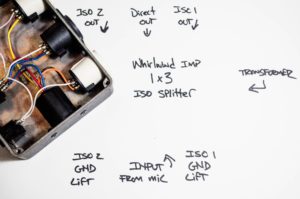As an Amazon Associate DcSoundOp earns from qualifying purchases.

The biggest difference between a line and microphone transformer splitter, is the amount of signal the transformer can cope with before saturation and distortion occur. It is important to be sure you are are using transformers capable of handling the signal you are sending them, otherwise it’s likely to compromise you signal chain down stream of the split. The unit we look at in this video also has a few other handy features.
With this first look at the topic, we start by taking apart a very basic Whirlwind Line Balancer Splitter box. We have a poke around inside and talk about how it works. As a simple passive transformer splitter, this unit gives us a chance to talk about the basics of splitting line level signals, isolating the various equipment we connect together, and balancing otherwise unbalanced signals for longer runs.
These are very useful boxes to have on hand and once you start carrying one, I’m sure you’ll find yourself using it more often than expected to solve all sorts of problems that arise on a daily basis.
Beyond the simplicity of passive splitters, in future videos we will take a look at active splitting and distribution amplifiers that are commonly found in broadcast and installed systems. These are often used when the need arises to split or divide a line level signal amongst many destinations, again with consideration given for isolation and balancing when required.
If you want to read more about the Line Balancer Splitter, I have included a link to the PDF cut sheet here – Whirlwind PDF – Line Balancer Splitter
And if you want to get deeper into transformers in general, here is a fantastic resource from Jensen and Bill Whitlock that will take you where you want to go – Jensen PDF – Audio Transformers by Bill Whitlock
And here is a good read from the Rane Notes Library on Sound System Interconnection, which touches on transformer isolation and splitting.
Thanks for stopping by, leave any questions or comments you have below or in the comments on the YouTube video. You can also e-mail me directly from the link at the top of every page.
Amazon and the Amazon logo are trademarks of Amazon.com, Inc, or its affiliates.

